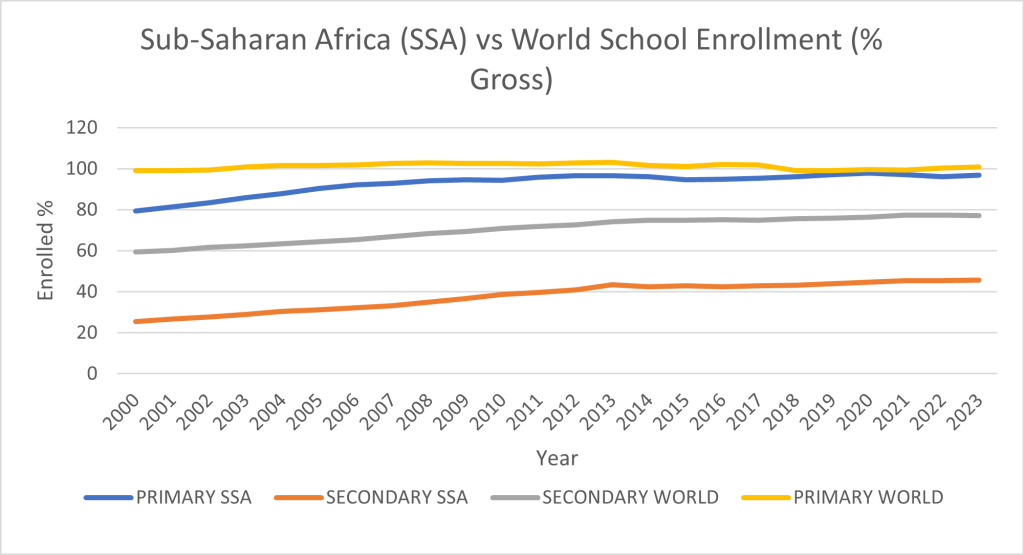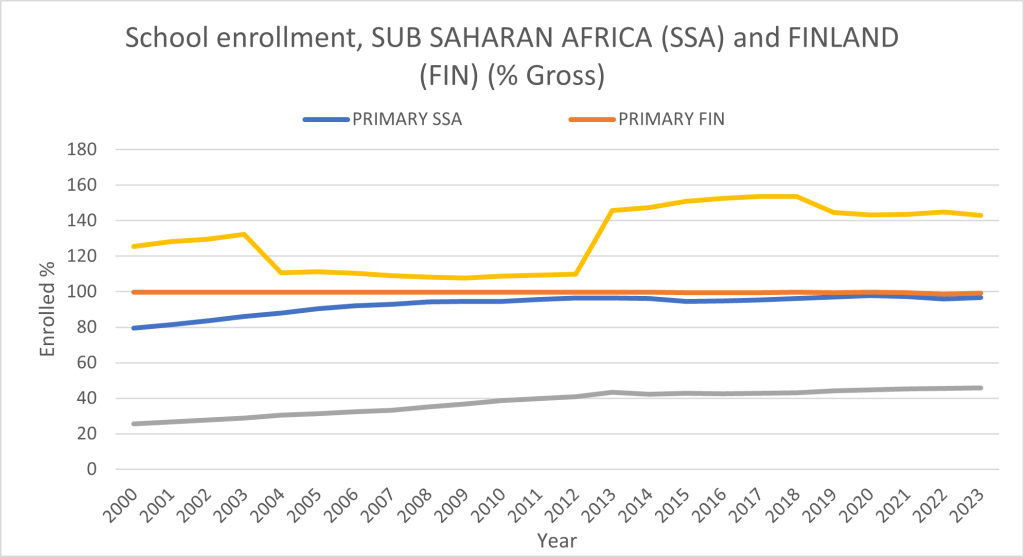
20 Nov When the Bell Rings Unevenly: Finland and Africa in the Global Classroom
The sound of opportunity does not reverberate evenly in the global classroom. For some, the school bell is loud and heard as the beginning of their lifetime learning routine, while the same bell goes muted for others before they even find their seat. In Sub-Saharan Africa, millions of children manage to reach their primary school door, but face a big struggle to move beyond. In contrast, children in Finland, regardless of background, walk through an open bridge of education starting from early learning to higher studies. In today’s world, where education drives economic mobility, workforce readiness, and gender equality, understanding this contrast is essential for designing systems that deliver continuity rather than just access.
A Case Study in Sub-Saharan Africa

Source: World Bank
Universal education is still a harsh dream in Sub-Saharan Africa. Primary education enrollment has improved significantly over the past two decades. But the transition to secondary school remains a problem. According to UNESCO, over 56 million young people aged 15–24 in the region have not completed primary school, and around 98 million children aged 6-18 remain out of school. This is clearly reflected in Figure 1. It shows the trend analysis between Sub-Saharan Africa (SSA) and the world from 2000 to 2023, where the primary enrolment in SSA has constantly increased, reaching approximately the global levels (around 100%), while the secondary enrolment remains lower (45-50%) compared to the global level (80%). This inequality arises due to the following reason:
- Economic Vulnerability: Sub-Saharan Africa remains the world’s poorest region, with 40% of the population living below the international poverty line, says the World Bank. Families often prioritise daily survival over school expenses such as uniforms, transport and lost labour.
- Teacher shortages and lack of infrastructural facilities: According to UNESCO, SSA needs 15 million additional teachers by 2023 to achieve universal education. Classrooms in rural areas are overcrowded and have only limited learning materials.
- Failures in transition: People in SSA see secondary education as a privilege, and hence the secondary school participation rate is much lower compared to the global level.
- Gender Inequality: Gender plays a critical role in creating an uneven educational rhythm. UNESCO data shows:
- 9 million girls in SSA will never attend school; compared to 6 million boys.
- 1 in 3 young women exits the education system due to child marriage or early pregnancy before 18.
- Girls spend twice as much time as boys on unpaid household labor, reducing time for school and study.
The inequality isn’t confined to classrooms, it is embedded in social norms that decide whose education matters most.
Data Deep Dive: When Numbers Tell the Story

Source: World Bank
Figure 2 makes the rhythm more visible. It compares the school enrollment rates in Sub-Saharan Africa (SSA) and Finland (FIN) between 2000 and 2023, narrating an evident difference in educational access and progression. The primary enrollment in SSA has gradually improved from 80% in the early 2000s to nearly universal levels after 2015. Whereas, in Finland, the primary enrollment stays closer to 100% for a very long period, reflecting an equitable education system with steady access and completion rates. The real problem arises in the transition period, i.e., from primary school to secondary school enrollment. SSA’s secondary school enrollment might show a steady improvement, but it lies far below Finland’s enrollment rate (120%). This ‘enrollment cliff’ clearly shows the system failure in SSA’s educational progression, where many students find it hard to move from primary to secondary school.
Learning from Finland’s Harmony
Finland is a great example to show what happens when equality becomes the main essence of the country’s education system. Its system works on trust, welfare and inclusion. The key components that drive its success include:
- Universal Welfare Support: Finnish students receive free school materials (like textbooks & stationery), free school meals, and transportation aids. The entire system operates with zero tuition fee at any level.
- Highly Qualified Teachers & Community-Based Schools: Schools in Finland are kept small, community-based and collaborative. The system employs highly qualified teachers.
- Gender-Sensitive Ecosystem: The inclusive quality has led to higher female enrollment and completion rates compared to males in secondary and higher education. This success is achieved through universal school meals, gender-sensitive teaching, and strong welfare support. These initiatives motivate girls to attend school, protecting them from becoming victims of the unpaid domestic labour market caused by food scarcity.
- Universal School Meals: The principle is very simple, yet effective. The “Feed every child, every day” motto works for the families who are in poverty. It removes the hidden costs of education and provides a tangible incentive to maintain regular attendance. It promotes gender equality by addressing food scarcity, which is a major factor conditioning girls to do domestic chores. Research shows school meals can increase female enrollment by up to 9%.
Conclusion
The disparities in global education are not permanent, they are structural. And structures can be redesigned. Sub-Saharan Africa can harmonize its educational rhythm by adopting inclusive, welfare-linked policies such as universal school meals, strengthening teacher capacity, and integrating gender-sensitive approaches. Education should be a welcoming bell, one that sounds the same for every child, regardless of birthplace or background. When learning conditions align with dignity, access, and continuity, the global classroom will no longer be divided by sound; but united by shared opportunity.
Blog by Samyuktha Purusothaman Nair,
Research Analyst, Frost & Sullivan Institute
